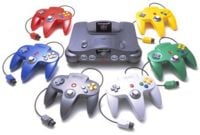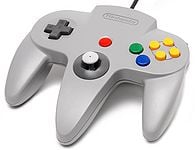Nintendo 64
Template:Articleabout Template:System-Infobox Template:LLQuote
The Nintendo 64 is a video game console created by Nintendo. It was released in 1996 to compete with the Sega Saturn and the Sony PlayStation.
The Nintendo 64 was popular for many reasons, one of the big ones being the release of Super Mario 64. Super Mario 64 was one of the first games of its kind to feature full 3D graphics and depth of field effects. The Nintendo 64 was able to pull this off because it was the first system to feature a 64-bit processor and 32-bit graphics chip (aside from the failed Atari Jaguar, which was really multiple co-processors using 64 bit architecture on a 32-bit main processor). The Nintendo 64 also featured the first successful analog control stick implementation and four built-in controller ports, unlike it's competitors, the PlayStation and the Sega Saturn. The Nintendo 64 is also noted as the last home console system to use cartridges, before Nintendo started using discs like its competitors and the cancelled "SNES CD" add-on.
The Nintendo 64 hosts a wide variety of games, but most of its hits are first-party titles such as Super Mario 64, Super Smash Bros., Mario Kart 64, Mario Party, Paper Mario, Star Fox 64, The Legend of Zelda: Ocarina of Time, and F-Zero X. Rareware, however, developed quite a few hits for the N64, such as GoldenEye 007, Banjo-Kazooie, and Donkey Kong 64. Production of the Nintendo 64 ended in 2002. The Nintendo 64 sold 32.93 million units during its lifetime.
In 1999, Nintendo released the Nintendo 64DD. The "DD" in Nintendo 64DD stood for "disk drive", and originally "dynamic drive". An add-on device for the Nintendo 64, it was a machine that allowed games to be played in a disk format, similar to zip disks. These were intended as a cheaper version of the Sega Saturn's game disks and the PlayStation's, but the Nintendo 64DD ended up being a commercial failure due to the way it was sold and was never released outside Japan. In total, four Mario games were released on the 64DD, all in the Mario Artist series.
In 2003, the so-called iQue Player was released in the Chinese market only, serving as the Chinese equivalent of the Nintendo 64, albeit with a differently designed controller. Its D-Pad and analog stick are placed as on the Nintendo GameCube controller[1]. The entire system only consists of the controller, which has the chip on-board. It has a limited selection of Mario titles, all of which were released for the Nintendo 64 outside China. These include Super Mario 64, Mario Kart 64, Paper Mario, Yoshi's Story, Dr. Mario 64, and Super Smash Bros.
Nintendo 64 controller
The Nintendo 64 Controller is the standard controller for the Nintendo 64. It is unique among video game controllers, as it has three grips instead of the more common two, most likely done because Nintendo was worried that 3D gaming wouldn't catch on, so they made a separate grip for the Control Pad. There are many color variations of the controllers, including solid colors and clear colors, the many different colored controllers being a unique concept at the time.
Contrary to popular belief, the Nintendo 64 is not the first console to use analog control sticks; it is just the first successful console to use them. The Vectrex was the first home console to have an analog stick; it also had four controller ports, something else that wasn't popularized until the Nintendo 64.
Buttons
The Nintendo 64 controller lost the and
buttons from the SNES, and also lost the (
) button, but instead featured additional buttons:
- A (
 )
) - B (
 )
) - Camera Buttons/C Buttons
 *
*
- Camera Up/C-Up (
 ) *
) * - Camera Right/C-Right (
 ) *
) * - Camera Down/C-Down (
 ) *
) * - Camera Left/C-Left (
 ) *
) *
- Camera Up/C-Up (
- START (
 )
) - Z Trigger (
 ) *
) * - R Trigger (
)
- L Trigger (
)
- Control Stick (
 ) *
) * - Control Pad (
)
* - Signifies new buttons
The Nintendo 64 has made a few appearances in Mario games as an easter egg. Francis, from Super Paper Mario also owns a Nintendo 64 as well as a Nintendo GameCube, Virtual Boy and Wii. It is found in Wario World as a treasure. It can also be seen in the background of a level in Yoshi's Story.
A Nintendo 64, with the controller, the Super Smash Bros. game cartridge, and box, appears in Super Smash Bros. Melee in the background of the stand where all of the player's trophies are. In Super Smash Bros. Brawl, one of the names that can appear whenever a player presses the random button when they're naming their custom stage is N64, which is a reference to the old system.
Game gallery
- MG64.PNG
- MP1 Cover.png
- MP2BOX.PNG
- MP3BOX.PNG
- MT64.PNG
- Papermario.jpg
- SuperSmashBros.JPG
Trivia
- Guinness World Records 2011 Gamer's Edition states that Super Mario Bros. was ported to the Nintendo 64, which is false.
- Several Nintendo 64 games depict the cartridges with a different artwork than their corresponding box arts (e.g. Super Mario 64, Mario Kart 64, Donkey Kong 64, etc).
- In Japan, the Nintendo 64 was discontinued before the Super Famicom.
- Super Mario 64 defined the layout of the N64 controller: The analog stick
 and
and  Buttons respectively being incorporated for better movement in a 3D environment and better free-camera control.[2]
Buttons respectively being incorporated for better movement in a 3D environment and better free-camera control.[2] - Luigi's Mansion, a Nintendo GameCube game, was originally a tech demo for the Nintendo 64.
- There is a difference in the PAL version of the Nintendo 64 in that it runs on 25 fps and 50 Hz as opposed to the 30 fps and 60 Hz of the NTSC and Japanese versions. Because of this, the PAL version has a slower frame rate and lower-pitched audio.
- This was the first Nintendo home console to use the same name and design between international and Japan.
References
| Nintendo 64 games | ||
|---|---|---|
| Super Mario franchise | Super Mario 64 (1996) • Mario Kart 64 (1996) • Mario no Photopi (1998) • Mario Party (1998) • Mario Golf (1999) • Mario Artist: Paint Studio* (1999) • Mario Party 2 (1999) • Mario Artist: Talent Studio* (2000) • Mario Artist: Communication Kit* (2000) • Mario Tennis (2000) • Paper Mario (2000) • Mario Artist: Polygon Studio* (2000) • Mario Party 3 (2000) • Dr. Mario 64 (2001) | |
| Donkey Kong franchise | Diddy Kong Racing (1997) • Donkey Kong 64 (1999) | |
| Yoshi franchise | Yoshi's Story (1997) | |
| Crossovers | Super Smash Bros. (1999) | |









